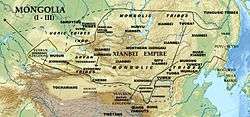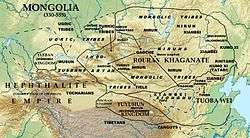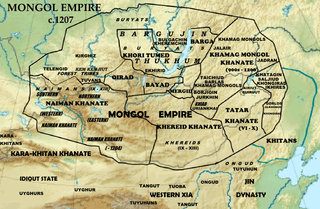Tuoba
Tuoba (Chinese: 拓拔; pinyin: Tuòbá; Wade–Giles: T'o-pa) was a clan of the Xianbei in ancient China. In the Old Turkic language, they were referred to as Tabgach.[1]
The Tuoba founded the Northern Wei (386–535) around the Yellow River delta and became increasingly sinicized. As a result, from 496, the name "Tuoba" disappeared by an edict of Emperor Xiaowen of Northern Wei, who adopted the Chinese language surname of Yuan (元) instead. A surviving branch of the Tuoba established the state of Tuyuhun before submitting as a vassal of the Tang dynasty; they later established the later Western Xia, whose rulers adopted the Chinese surname Li (李). The ruling families of the Western Wei and Northern Zhou dynasties that followed the fall of Northern Wei were also of Tuoba ethnicity.
History




The distribution of the Xianbei people ranged from present day Northeast China to Mongolia, and the Tuoba were one of the largest clans among the western Xianbei, ranging from present day Shanxi province and westward and northwestward. They established the state of Dai from 310-376 CE[2] and ruled as the Northern Wei from 386-536. The Tuoba states of Dai and Northern Wei also claimed to possess the quality of earth in the Chinese Wu Xing theory. All the chieftains of the Tuoba were revered as emperors in the Book of Wei and the History of the Northern Dynasties. Some scholars suggest that the Tuoba were proto-Mongols (and spoke a proto-Mongolic language) or belonged to their own branch of Ural-Altaic language family,[3][4] although some also suggest that instead of being related to the Mongols, they were perhaps related to the Turkic peoples (and spoke a proto-Turkic language).[5][6][7] In the opinion of Peter Boodberg, much of the Tuoba vocabulary was "essentially Turkish with a certain admixture of Mongolian elements".[8] On the other hand, Edwin Pulleyblank "concluded that it was Mongolian."[3] Chen Sanping observes that the Tuoba language "had both" elements.[9] On the other hand, Liu Xueyao stated that Tuobas may have had their own language which should not be assumed to be identical with any other known languages.[10] The Rourans considered that Tuoba and Rourans descended from common ancestors. [11] Also a historian of the Northern Wei noted that Rourans descended from Xianbei.
Marriage policies
The Northern Wei started to arrange for Han Chinese elites to marry daughters of the Xianbei Tuoba royal family in the 480s.[12] Some Han Chinese exiled royalty fled from southern China and defected to the Xianbei. Several daughters of the Xianbei Tuoba Emperor Xiaowen of Northern Wei were married to Han Chinese elites, the Han Chinese Liu Song royal Liu Hui 刘辉, married Princess Lanling 蘭陵公主 of the Northern Wei,[13][14] Princess Huayang 華陽公主 to Sima Fei 司馬朏, a descendant of Jin dynasty (265–420) royalty, Princess Jinan 濟南公主 to Lu Daoqian 盧道虔, Princess Nanyang 南阳长公主 to Xiao Baoyin 萧宝夤, a member of Southern Qi royalty.[15] Emperor Xiaozhuang of Northern Wei's sister the Shouyang Princess was wedded to The Liang dynasty ruler Emperor Wu of Liang's son Xiao Zong 蕭綜.[16]
When the Eastern Jin dynasty ended Northern Wei received the Han Chinese Jin prince Sima Chuzhi 司馬楚之 as a refugee. A Northern Wei Princess married Sima Chuzhi, giving birth to Sima Jinlong 司馬金龍. Northern Liang Xiongnu King Juqu Mujian's daughter married Sima Jinlong.[17]
Chieftains of Tuoba Clan 219-377 (as Princes of Dai 315-377)
| Posthumous name | Full name | Period of reign | Other |
|---|---|---|---|
| 神元 Shényuán | 拓拔力微 Tuòbá Lìwéi | 219-277 | Temple name: 始祖 Shízǔ |
| 章 Zhāng | 拓拔悉鹿 Tuòbá Xīlù | 277-286 | |
| 平 Píng | 拓拔綽 Tuòbá Chuò | 286-293 | |
| 思 Sī | 拓拔弗 Tuòbá Fú | 293-294 | |
| 昭 Zhāo | 拓拔祿官 Tuòbá Lùguān | 294-307 | |
| 桓 Huán | 拓拔猗㐌 Tuòbá Yītuō | 295-305 | |
| 穆 Mù | 拓拔猗盧 Tuòbá Yīlú | 295-316 | |
| None | 拓拔普根 Tuòbá Pǔgēn | 316 | |
| None | 拓拔 Tuòbá[18] | 316 | |
| 平文 Píngwén | 拓跋鬱律 Tuòbá Yùlǜ | 316-321 | |
| 惠 Huì | 拓拔賀傉 Tuòbá Hèrǔ | 321-325 | |
| 煬 Yáng | 拓拔紇那 Tuòbá Hénǎ | 325-329 and 335-337 | |
| 烈 Liè | 拓拔翳槐 Tuòbá Yìhuaí | 329-335 and 337-338 | |
| 昭成 Zhaōchéng | 拓拔什翼健 Tuòbá Shíyìjiàn | 338-377 | Regnal name: 建國 Jiànguó |
See also
- Chinese sovereign
- History of China
- Jin dynasty (265–420)
- Khitan people
- Ethnic groups in Chinese history
References
- Zuev Yu.A. "Ethnic History Of Usuns", Works of Academy of Sciences Kazakh SSR, History, Archeology And Ethnography Institute, Alma-Ata, Vol. VIII, 1960, (In Russian)
- Bazin L. "Research of T'o-pa language (5th century AD)", T'oung Pao, 39/4-5, 1950 ["Recherches sur les parlers T'o-pa (5e siècle après J.C.)"] (In French) Subject: Toba Tatar language
- Boodberg P.A. "The Language of the T'o-pa Wei", Harvard Journal of Asiatic Studies, Vol. 1, 1936
- Pelliot P.A. "L'Origine de T'ou-kiue; nom chinoise des Turks", T'oung Pao, 1915, p. 689
- Pelliot P.A. "L'Origine de T'ou-kiue; nom chinoise des Turks", Journal Asiatic, 1925, No 1, p. 254-255
- Pelliot P.A. "L'Origine de T'ou-kiue; nom chinoise des Turks", T'oung Pao, 1925–1926, pp. 79–93;
- Clauson G. "Turk, Mongol, Tungus", Asia Major, New Series, Vol. 8, Pt 1, 1960, pp. 117–118
- Grousset R. "The Empire of the Steppes: A History of Central Asia", Rutgers University Press, 1970, p. 57, 63-66, 557 Note 137, ISBN 0-8135-0627-1
Notes
- ↑ Grousset, Rene (1970). The Empire of the Steppes. Rutgers University Press. pp. 60–65. ISBN 0-8135-1304-9.
- ↑ Grousset, Rene (1970). The Empire of the Steppes. Rutgers University Press. p. 57. ISBN 0-8135-1304-9.
- 1 2 Holcombe 2001, p. 132.
- ↑ Holcombe 2011, p. 65.
- ↑ Kang-i Sun Chang,Stephen Owen (2010). The Cambridge History of Chinese Literature, Vol. 1. Cambridge University Press. p. 272.
- ↑ Evelyn S. Rawski (2015). Early Modern China and Northeast Asia. p. 123.
- ↑ Mote, Frederick W. (2003). Imperial China 900-1800. p. 170.
- ↑ Charles Holcombe (2001). The Genesis of East Asia: 221 B.C. - A.D. 907. p. 132.
- ↑ Holcombe 2001, p. 248
- ↑ Liu Xueyao p. 83-86
- ↑ Hyacinth (Bichurin), Collection of information on peoples lived in Central Asia in ancient times, 1950. p.209
- ↑ Rubie Sharon Watson (1991). Marriage and Inequality in Chinese Society. University of California Press. pp. 80–. ISBN 978-0-520-07124-7.
- ↑ Wendy Swartz; Robert Campany; Yang Lu; Jessey Choo (21 May 2013). Early Medieval China: A Sourcebook. Columbia University Press. pp. 157–. ISBN 978-0-231-15987-6. Cite uses deprecated parameter
|coauthors=(help) - ↑ Papers on Far Eastern History. Australian National University, Department of Far Eastern History. 1983. p. 86.
- ↑ China: Dawn of a Golden Age, 200-750 AD. Metropolitan Museum of Art. 2004. pp. 30–. ISBN 978-1-58839-126-1.
- ↑ Ancient and Early Medieval Chinese Literature (vol.3 & 4): A Reference Guide, Part Three & Four. BRILL. 22 September 2014. pp. 1566–. ISBN 978-90-04-27185-2.
- ↑ China: Dawn of a Golden Age, 200-750 AD. Metropolitan Museum of Art. 2004. pp. 18–. ISBN 978-1-58839-126-1.
- ↑ No known given name survives.